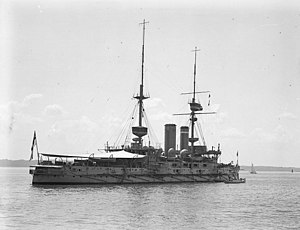 HMS Implacable after the addition of fire control platforms to her foremast and mainmast.
| |
| History | |
|---|---|
| Name | HMS Implacable |
| Builder | Devonport Dockyard |
| Laid down | 13 July 1898 |
| Launched | 11 March 1899 |
| Completed | July 1901 |
| Commissioned | 10 September 1901 |
| Decommissioned | 1919 |
| Fate | Broken up, 8 November 1921 |
| General characteristics | |
| Class and type | Formidable-class battleship |
| Displacement | |
| Length | 431 ft 9 in (131.6 m) o/a |
| Beam | 75 ft (22.9 m) |
| Draught | 25 ft 11 in (7.90 m) |
| Installed power |
|
| Propulsion | |
| Speed | 18 knots (33 km/h; 21 mph) |
| Range | 5,500 nmi (10,190 km; 6,330 mi) at 10 knots (19 km/h; 12 mph) |
| Complement | 780 |
| Armament |
|
| Armour | |
HMS Implacable was a Formidable-class battleship of the British Royal Navy, the second ship of the name. The Formidable-class ships were developments of earlier British battleships, featuring the same battery of four 12-inch (305 mm) guns—albeit more powerful 40-calibre versions—and top speed of 19 knots (35 km/h; 22 mph) of the preceding Canopus class, while adopting heavier armour protection. The ship was laid down in July 1898, was launched in March 1899, and was completed in July 1901. Commissioned in September 1901, she was assigned to the Mediterranean Fleet and served with the fleet until 1908. After a refit, she transferred to the Channel Fleet, then onto the Atlantic Fleet in May 1909. By now rendered obsolete by the emergence of the dreadnought class ships, she was assigned to the 5th Battle Squadron and attached to the Home Fleet in 1912.
Upon the outbreak of the First World War, Implacable, along with the squadron was assigned to the Channel Fleet. After operations with the Dover Patrol, she served in the Dardanelles Campaign in support of the Allied landings at Gallipoli. She participated in the Landing at Cape Helles on 25–26 April and supported ANZAC forces ashore over the course of the following month. In late May 1915, she was withdrawn to reinforce the Italian fleet at the southern end of the Adriatic Sea after Italy joined the war on the side of the Allies. She remained in the Mediterranean until June 1917, apart from a brief return to Britain in March and April 1916 for a refit. After returning to England, she was laid up until March 1918, when she was converted for use as a depot ship for the Northern Patrol. After the war, she was decommissioned and eventually sold for scrap in 1921.